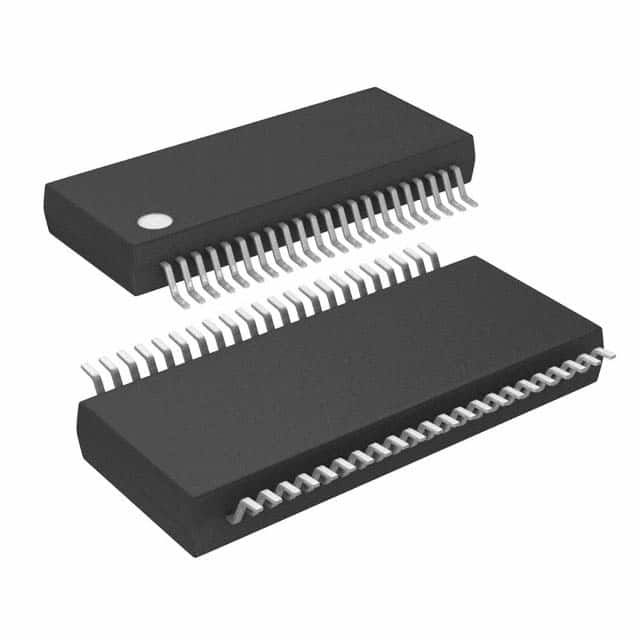LTC6803HG-3#PBF
Product Overview
Category
The LTC6803HG-3#PBF belongs to the category of integrated circuits (ICs) specifically designed for battery monitoring and balancing applications.
Use
This product is primarily used for monitoring and managing the performance of battery packs in various applications, such as electric vehicles, renewable energy systems, and portable electronics.
Characteristics
- Battery Monitoring: The LTC6803HG-3#PBF provides accurate measurement and monitoring of individual cell voltages in a battery pack.
- Balancing Functionality: It offers built-in balancing circuitry to equalize the charge levels of individual cells within a battery pack.
- High Precision: The IC ensures high accuracy in voltage measurements, enabling precise monitoring of battery health.
- Robust Design: It features a robust architecture that can withstand harsh operating conditions and provides reliable performance.
- Low Power Consumption: The LTC6803HG-3#PBF is designed to minimize power consumption, making it suitable for battery-powered applications.
- Communication Interface: It supports a serial communication interface for easy integration with microcontrollers or other control systems.
Package and Quantity
The LTC6803HG-3#PBF is available in a compact 48-pin SSOP (Shrink Small Outline Package) package. It is typically sold in reels containing a specified quantity of ICs.
Specifications
- Cell Voltage Measurement Range: 0V to 5V
- Number of Cells Monitored: Up to 12 cells
- Balancing Current: Up to 100mA per cell
- Operating Temperature Range: -40°C to +85°C
- Supply Voltage Range: 2.7V to 5.5V
- Communication Interface: SPI (Serial Peripheral Interface)
- Dimensions: 10.3mm x 6.1mm x 1.75mm
Pin Configuration
The LTC6803HG-3#PBF features a 48-pin SSOP package with the following pin configuration:

Functional Features
- Cell Voltage Monitoring: The LTC6803HG-3#PBF can measure and monitor the voltage of each individual cell within a battery pack.
- Balancing Functionality: It includes built-in balancing circuitry to equalize the charge levels of cells, ensuring optimal performance and longevity of the battery pack.
- Fault Detection: The IC can detect various faults, such as overvoltage, undervoltage, and overtemperature conditions, providing enhanced safety and protection.
- Communication Interface: It supports SPI communication, allowing easy integration with microcontrollers or other control systems for data retrieval and analysis.
- Low Power Consumption: The LTC6803HG-3#PBF is designed to minimize power consumption during operation, extending the battery life.
Advantages and Disadvantages
Advantages
- Accurate and precise cell voltage monitoring
- Built-in balancing functionality reduces the need for external balancing circuits
- Robust design suitable for harsh operating conditions
- Low power consumption extends battery life
- Comprehensive fault detection enhances safety
Disadvantages
- Limited to monitoring and balancing up to 12 cells
- Requires additional external components for complete battery management system implementation
Working Principles
The LTC6803HG-3#PBF operates by measuring the voltage of each individual cell in a battery pack using an internal analog-to-digital converter (ADC). It then communicates these measurements to an external microcontroller or control system via the SPI interface. The IC also incorporates balancing circuitry that redistributes charge among cells to maintain their charge levels within a specified range.
Application Field Plans
The LTC6803HG-3#PBF finds extensive application in various fields, including:
- Electric Vehicles: It is used to monitor and manage the battery packs in electric vehicles, ensuring optimal performance and safety.
- Renewable Energy Systems: The IC enables efficient monitoring and balancing of battery banks in solar or wind energy systems, maximizing energy storage capacity.
- Portable Electronics: It can be employed in portable electronic devices, such as laptops and smartphones, to monitor battery health and prevent overcharging or discharging.
Alternative Models
- LTC6803-1#PBF: Similar to LTC6803HG-3#PBF but with a different package and pin configuration.
- LTC6803IG-2#PBF: A lower-cost alternative with reduced features and capabilities.
- LTC6803CG-4#PBF: An upgraded version with extended temperature range and enhanced fault detection capabilities.
These alternative models provide flexibility in choosing the most suitable option based on specific requirements and budget considerations.
In conclusion, the LTC6803HG-3#PBF is a highly capable integrated circuit designed for battery monitoring and balancing applications. With its accurate measurement, built-in balancing
10个与LTC6803HG-3#PBF在技术解决方案中的应用相关的常见问题及解答
Sure! Here are 10 common questions and answers related to the application of LTC6803HG-3#PBF in technical solutions:
Q: What is the LTC6803HG-3#PBF?
A: The LTC6803HG-3#PBF is a high-precision battery stack monitor IC designed for multi-cell battery monitoring applications.Q: What is the maximum number of cells that can be monitored using LTC6803HG-3#PBF?
A: The LTC6803HG-3#PBF can monitor up to 12 series-connected battery cells.Q: How does LTC6803HG-3#PBF measure cell voltages?
A: It measures cell voltages using an internal multiplexed ADC (Analog-to-Digital Converter).Q: Can LTC6803HG-3#PBF measure temperature as well?
A: Yes, it has built-in temperature measurement capability for each cell.Q: What is the communication interface used by LTC6803HG-3#PBF?
A: It uses a serial interface called SPI (Serial Peripheral Interface) for communication with a microcontroller or host system.Q: Is LTC6803HG-3#PBF suitable for automotive applications?
A: Yes, it is designed to meet the stringent requirements of automotive applications.Q: Can LTC6803HG-3#PBF detect overvoltage and undervoltage conditions?
A: Yes, it has built-in overvoltage and undervoltage detection circuits for each cell.Q: Does LTC6803HG-3#PBF support balancing of battery cells?
A: No, it does not have built-in cell balancing functionality. External circuitry is required for cell balancing.Q: What is the operating voltage range of LTC6803HG-3#PBF?
A: It operates from 2.7V to 5.5V, making it suitable for a wide range of battery-powered applications.Q: Can multiple LTC6803HG-3#PBF ICs be daisy-chained together?
A: Yes, multiple LTC6803HG-3#PBF ICs can be connected in a daisy-chain configuration to monitor larger battery stacks.
Please note that these answers are general and may vary depending on the specific application and requirements.


